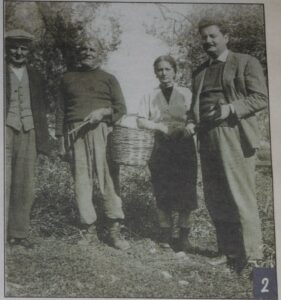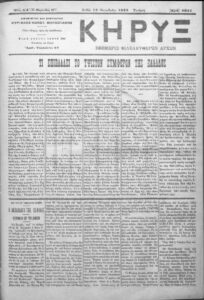The metochi estates: the non-exchangeable estates
City
Migration Period
City Narratives
Full Description
The Population Exchange Agreement also determined the fate of the Cretan Muslims who were European citizens and were allowed to remain on the island. In addition to those who had European citizenship prior to 1923, several affluent Muslims attempted to acquire the Italian or, more commonly, the French citizenship in order to stay in Crete. Some succeeded.
Some of the Cretan Muslims who were European citizens owned metochi estates. Since they were deemed exempt from the exchange, their properties were not appropriated. As a result, their estates remained intact and continued to operate as residential and agricultural units, unlike the estates which were deemed exchangeable and were divided among the refugees as part of their rehabilitation.
Some of these estates hosted refugees temporarily when they first arrived after September 1922. Several changed hands many times until they were eventually purchased by Christians and are still operational today. The metochi estates that continue to operate as agricultural units have historically employed labour brought to the island by later population movements and many of today’s migrants and refugees work there.
The most important metochi estates that were deemed non-exchangeable were the estates of Ibrahim Veyzade, Yetim Agha, Sakir Bey, Kalliterakis, and Kindelis. These estates not only continued to operate, but have also featured in the local history of population movement throughout the 20th and 21st century.
The metochi of Ibrahim Beyzade hosted Asia Minor refugees after the Catastrophe. The ownership status of the estate was unclear at the time, since the estate’s owner had been murdered before the Catastrophe and some of his heirs were apparently convicted of instigating his murder. The state took advantage of the disarray and accommodated refugees on the estate until the matter of its ownership was settled. When it was determined that the metochi would remain in private hands, the state withdrew and the refugees were expelled from the estate. Soon, the land was sold to a local Christian whose family still owns it today. The photograph presented here, reproduced from a relevant article by M. Manousakas, depicts one of the two water fountains that used to be inside Ibrahim Beyzade’s house. The basin of the fountain was made out of black marble, a sign of the owner’s wealth.
The metochi of Yetim Agha was also declared non-exchangeable. Yetim Agha was an Italian citizen, which allowed him to hold on to his expansive property. This metochi, which lies west of the city of Chania towards Agyia, was only part his holdings. Lands and residences belonging to Yetim Agha sprawled to the north all the way to the sea, to the west to the area of Makrys Toichos, and to the south to Vamvakopoulos. M. Manousakas notes that although a part of this huge estate was eventually granted to Asia Minor refugees, the majority remained in the hands of Yetim Agha. He died in Chania at the end of the Interwar and the estate was passed on to his children, essentially managed by his son, Ibrahim Bey, who lived in Chania until the end of his life. Until the 1960s, Ibrahim employed Antonis Fatseas, the son of a migrant who came from Kithyra to Crete, to take care of the trees and the rest of the estate. In the accompanying photograph, we can see the son of Yetim Agha (on the left, wearing a cap) with Antonis Fatseas. More recent migrants to Crete also found employment on the estate, such as an Albanian stonemason, whose name is not mentioned in the article, who restored part of the stone wall surrounding the metochi, depicted in the next photograph.
The metochi of Sakir Bey, which was north of the village Mournies, was one of the most imposing metochi estates in Chania. Sakir Bey Agazades was a French citizen. The estate manor was itself ‘a testament to multiple cultural heritages […] between the 16th and the 19th century’, according to P. Trimandili – Magan. Even before the population exchange, several buildings in Chania were used to temporarily house the first refugees from Asia Minor. The newspaper pieces in this entry indicate that this metochi also hosted refugees during those first few months after the Catastrophe. ‘Ioannis Fotiou, resident of France, is hereby notified that his sister, Katina G. Karabetsou, was rescued along with her family and fled to Chania, where she is staying at the estate of Sekir Bey’. Nevertheless, the metochi was not deemed exchangeable and remained under the ownership of Sekir Bey’s family until the 1950s, when it was divided and sold to locals therefore losing its designation as an agricultural unit. The photograph published on Facebook by the group ‘Old Photographs of Chania’ is a snapshot of life on the metochi of Sakir Bey in the 1930s. The owner himself is on the left wearing a hat and tie. The fact that the workers in the photograph vary in age is an indication of how dynamic the development of these agricultural units was in their heyday.
The Kalliterakis estate also belonged to a Muslim named Voskakis until 1937. It was deemed non-exchangeable because its owner was a European citizen. During the Interwar, it was sold to local Christians, the Kalliterakis family. At the time, the metochi produced olives, citrus, fruit, grapes, wheat and vegetables. Today, the estate remains active, systematically producing olives, citrus and avocadoes. This entry includes an excerpt from an interview with Ersi Kalaitzaki, one of the present owners of the estate. She explains how an estate of this kind, which has been continuously in operation for so many years, has remained productive and profitable over time.
Moreover, according to Katia Kalaitzaki-Kalliteraki, the estate’s co-owner, throughout its history, the metochi has employed several migrants and refugees. After the population exchange, refugee families that lived in the exchangeable estates, like Tsigkris, Mullah Hanum and Symisiako, worked in the Kalliterakis estate as farmers or houseworkers. Later, migrants and refugees from Syria, Russia, Albania, Georgia and Bulgaria also found employment on the estate. The recent photographs from the metochi depict the main entrance and the intricate stairway in the courtyard. The photographs are reproduced courtesy of the photographer, Stella Manioudaki.
Even though the Kindelis estate was deemed non-exchangeable, it still ended up housing Christians from Anatolia through a different route. Viktoria Kyriakou, a woman from Constantinople whose husband was from Chania, bought the estate from its Muslim owner around 1910 so that her family could relocate from Constantinople. The metochi was originally used as a secondary home, but became the family’s primary residence postwar when it also became their main source of income. The couple’s daughter married Giorgos Kindelis, a man from Asia Minor who had also moved to Chania before the population exchange and worked as an accountant at the Raisin Growers’ Union of Chania. The metochi still carries his name today and the estate has been continuously in operation as an autonomous agricultural unit. Nowadays, it produces organic goods and also operates as a guest house.
According to Danai Kindeli, one of the owners, a large number of people from various places around the world have worked on the estate permanently or seasonally. Initially, during the 1980s, the estate employed an internal migrant couple from Selinos in the Chania prefecture. Two other permanent workers were from England and Tunisia. During the last twenty years, a woman from Albania and a family from India have also been working at the metochi. The estate has also seasonally employed labourers from Armenia, Georgia, Bulgaria, Syria, Ukraine, Germany, Rumania and Italy. The photographs presented here were taken from the estate’s website and depict the metochi as it stands today. We can see that some of the typical features of the old metochi estates have been preserved. The first photograph shows how the auxiliary facilities are organised on the perimeter of the estate and the second depicts an old open water reservoir that still survives today.
Bibliography
Manolis Manousakas, ‘Photo-retrospectives in old Chania: 159. Metochi Ibraim Veizade’, Routes supplement, Chaniotika Nea (28/03/2008).
Manolis Manousakas, ‘Photo-retrospectives in old Chania: 226. Metochi Yetim Aga’, Routes supplement, Chaniotika Nea (25/07/2009).
Manolis Manousakas, ‘Photo-retrospectives in old Chania: 151. Metochi Sakir Bei’, Routes supplement, Chaniotika Nea (01/02/2008).
- Trimandili – Magan, ‘An important, well-defined, Turkish metochi and the history of the Agazade family’, 9th International Congress of Cretan Studies, Abstracts of Scientific Announcement, Society of Cretan Historical Studies, Heraklion 2001, pp. 279-280.
Metochi Kalliteraki, Since the 17th century. A centuries-old Venetian olive grove, official web site of Metochi Kalliteraki [https://www.metochi-kalliteraki.gr/el].
The history of Metochi Kindeli, official web site of Metochi Kindeli [https://www.metohi-kindelis.gr/el/about/].









